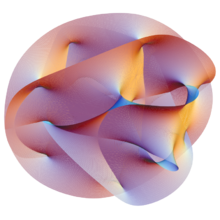- Heterotic string
-
This article is about string theory. For heterosis in biology, see Heterosis.
String theory 
Superstring theory TheoryConceptsRelated TopicsIn physics, a heterotic string is a peculiar mixture (or hybrid) of the bosonic string and the superstring (the adjective heterotic comes from the Greek word heterosis, hybrid vigour). In string theory, the left-moving and the right-moving excitations almost do not interact with each other, and it is possible to construct a string theory whose left-moving (counter-clockwise) excitations "think" that they live on a bosonic string propagating in D = 26 dimensions, while the right-moving (clock-wise) excitations "think" that they belong to a superstring in D = 10 dimensions.
The mismatched 16 dimensions must be compactified on an even, self-dual lattice (a discrete subgroup of a linear space). There are two possible even self-dual lattices in 16 dimensions, and it leads to two types of the heterotic string. They differ by the gauge group in 10 dimensions. One gauge group is SO(32) (the HO string) while the other is E8 × E8 (the HE string).
These two gauge groups also turned out to be the only two anomaly-free gauge groups that can be coupled to the N = 1 supergravity in 10 dimensions other than U(1)496 and E8 × U(1)248, which is suspected to lie in the swampland.
Heterotic string theory was first developed in 1985 by David Gross, Jeffrey Harvey, Emil Martinec, and Ryan Rohm (the so-called Princeton String Quartet[1]), in one of the key papers that fueled the first superstring revolution. A year later in 1986, Strominger derived the Strominger's equations which are the necessary and sufficient conditions for spacetime supersymmetry. In the 1990s, it was realized that the strong coupling limit of the HO theory is type I string theory — a theory that also contains open strings; this relation is called S-duality. On the other hand, the strongly coupled limit of the HE theory is M-theory compactified on a line interval (bounded by Horava-Witten domain walls, as explained by Petr Hořava and Edward Witten).
Every heterotic string must be a closed string, not an open string; it is not possible to define any boundary conditions that would relate the left-moving and the right-moving excitations because they have a different character.
A heterotic string is embedded in the membrane that creates harmonics on the string which translate into mass and energy through mechanisms discussed above.
References

This string theory-related article is a stub. You can help Wikipedia by expanding it.
